Unit 2 - Business Management SL
1/124
There's no tags or description
Looks like no tags are added yet.
Name | Mastery | Learn | Test | Matching | Spaced | Call with Kai |
|---|
No study sessions yet.
125 Terms
Human Resource Management Roles
The acquisition, training, motivation and reward of human resources within the business.
Under HRM, managers complete 3 main tasks:
Develop employees’ skills
Keep a loyal workforce
Respond to external changes.
Human Resource Planning (Workforce Planning)
The management function of using and developing people within a business to meet its organisational objectives.
Human Resources Planning looks at…
Historical data and trends
Sales and income levels
Labour turnover rates
The flexibility and workload of staff
Demographic changes
Internal Factors that Influence HR Planning
Corporate or overall objectives
Flexi-time
Type of product sold - does it need a skilled labor force?
External Factors that Influence HR Planning
Demographic Changes - net birth rate, migration rate, retirement, fertility rate, aging population
Labor Mobility
The extent to which labour can move to different locations and their flexibility to change jobs.
Geographical Mobility Limitations
Friends and family
Relocation costs
Fear of the unknown
Cost of living
Cultural differences
Occupational Mobility Limitations
Higher limitation with educations/qualifications/skills and experience
Younger people are more mobile
Immobile due to highly specialized skills
Discrimination
Reason for Worker Migration
Pay and remuneration
Employment opportunities
Seasonal factors
Domestic instability
Higher standards of living
New Communication Technologies Opportunities
Recruitment
Meetings
Appraisal, teleworking and homeworking
Online training courses
Flexible Working Patterns (implications)
Organizational restructuring - less likely to have a traditional structure
Flexitime - part-time employees
Changing recruitment practices - more part time and temporary workers
Retention of core staff - how to keep key staff
Training - training for types of staff (core)
Gig economy
A segment of service economy that consists of flexible, temporary or freelance jobs facilitated by online platforms. Workers lacks guarantee hours or pay. (e.g. Grab, Uber, Fedex)
Teleworking
Refers to working away from the office using electronic forms of communication. The trend is partly the result of increasing issues with traffic and commute and recent advances in technology.
Portfolio Working
A portfolio worker is an individual employed in numerous different jobs, carried out simultaneously, on a part-time or contemporary basis. The portfolio worker charges a free for each unit of work done.
Flexitime
Flexitime is a flexible way of working which allows employees to fit their working hours around their personal needs. Usually this is done through communication with the employer, and this can be applicable for home-working.
Resistance for change in workplace
Self-interest
Preference for current situation.
Differing assessment of the situation
Misunderstanding
Overcoming resistance to change
Education + Communication
Support
Negotiation
Explicit/implicit coercion
Manipulation + co-option
Organizational Structure
Human resources can be organized in different ways. Most businesses needs a formal and organized structure for accountability and responsibility (in charge of what, what position)
Role and Ranking
There are many roles in a company, which can be organized in a hierarchy of importance or power.
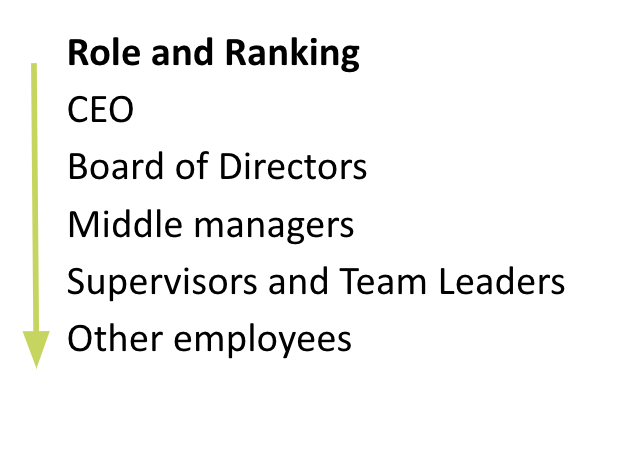
Delegation
It is not possible for one person who handle all the work in an organization. The passing of control and authority is known as delegation. (assigning tasks and responsibilities to employees)
Effective Delegation
Effective delegation and save time and allow managers to focus on other issues. It could further motivate and develop employees.
Poor delegation
Poor delegation can lead to confusion, feelings of inadequacy, and demotivate staff.
SMARTER Delegation
Specific, Measurable, Agreed, Realistic, Time-bound, Ethical, Record.
Span of Control
Refers to the number of people who are directly accountable (under) to manager. Someone higher up in the hierarchy, will have a wider span of control. CEOs only have control over a board of director so its narrow, indirectly, its very wide.
Wide Span of Control
Fewer layers in the hierarchy, less cost due to less managerial positions in the firm.
Communication would be more effective (in terms of speed and accuracy).
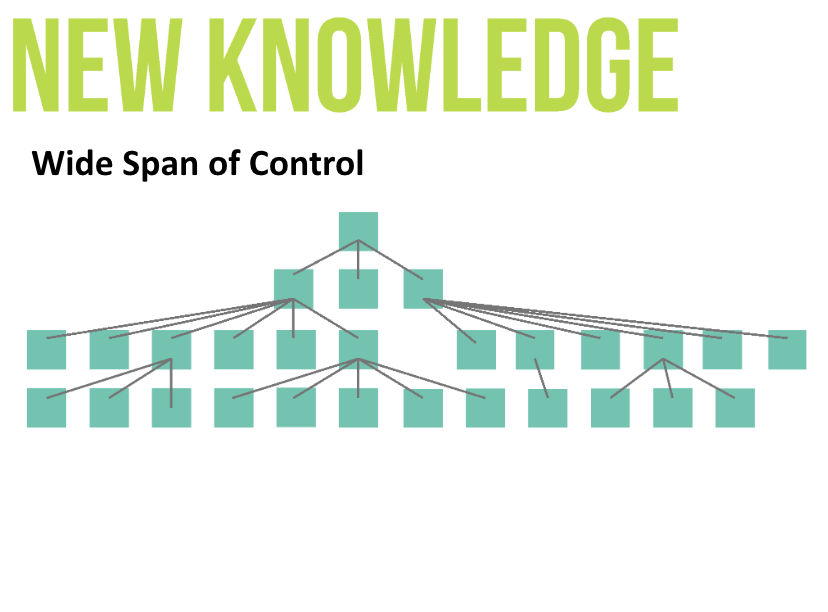
Narrow Span of Control
Fewer subordinate accountable to a manager. Easier to communicate and control, smaller teams can be more productive due to cohesiveness and spirit. This system can be more costly.
Manager’s Degree of Control - MOST
Manager - skills and experience
Organization structure - there might be cultures that require managers to closely monitor and control subordinates.
Subordinates - skilled staff are likely to work in smaller teams, managers having a wide span of control
Task - higher complexity task needs narrow span of control.
Levels of Hierarchy
Refers to organizational structure formed from a ranking system. At the top is CEO, chairperson, board, and at the other end is unskilled employees.
Pro/Con Hierarchal Structures
+Clear lines of communication, can improve coordination and productivity.
+Sense of belonging in different hierarchies.
- Departmentalisation, workers isolated to teams
- Inflexibility – hard to combat external changes
Chain of Command
The formal line of authority where orders are passed down. This can be seen through an organization chart. Few levels of hierarchy result in short chain of command.
Delayering
Delayering is the process of removing one or more levels in the hierarchy to flatten the organizational structure. This will widen span of control.
Pro/Con Delayering
+Reduce costs
+Improve communication speed
+ Encourages Delegation
- Create anxiety and sense of insecurity
- Overload staff
- Longer decision-making
Downsizing vs. Delayering
Downsizing involves reducing the workforce, maybe due to redundancy, while delayering means removing at least one level in the hierarccy, without anyone necessarily losing their jobs.
Bureaucracy
The execution of tasks that are governed by official administrative and formal organization rules. Bureaucratic organizations are characterized by policies, standardized procedures, formal hierarchies structures.
Excessive Administration in Bureaucracy
Frequent requirement to fill tedious paperwork
Staff working in multiple department, reporting to multiple managers.
Too many committees
Long chains of command
Managers with overlapping roles.
Bureaucratic organizations are governed by several principles:
Continuity - The establishment follows rules and regulations rather than taking high risks to maintain continuity.
Rules and regulations - Business activity is done according to official policies. There are clear lines of authority, responsibility, autonomy.
Hierarchical structures - Authority and responsibilities are part of formal hierarchies.
Accountability - Business activity is conducted with written evidence complying to the firm’s policies. Formality makes worker accountable.
Bureaucracy - Drawbacks
Most experts feel that bureaucracy hinders or prevent creativity and risk-taking, also slowing down decision-making, making organizations highly inflexible.
Centralization and decentralization
Decision-making power can be shared amongst the workforce or amongst a few people. The extent of dilution or concentration of authority depends on the skills and traits of employees in the organization. Decentralization means power is extended to a lot of people, centralization means limited amount of people.
Pro/Con Centralization
+ Rapid decision making
+ Better control
+ Efficiency
- Add pressure, stress to senior staff
- Inflexibility.
- Demotivating
- Delays in decision making
Which to choose: Centralization or Decentralization
Organization size - larger = greater need for decentralization
Scale of importance in the decision - decisions with high-cost risks will be centralized
Level of risk - high risk decisions will be centralized
Corporate culture
Matrix Structure
Task-oriented and based on teams. It tends to overcome many problems associated with traditional/hierarchical structures. It is a combination of vertical chain of command, operated through departments, and horizontal projects of product teams.
Organization Charts
An organizational chart is a diagram representation of the firm’s formal structure. It shows the functional departments, chain of command, span of control, communication channels and hierarchy levels.
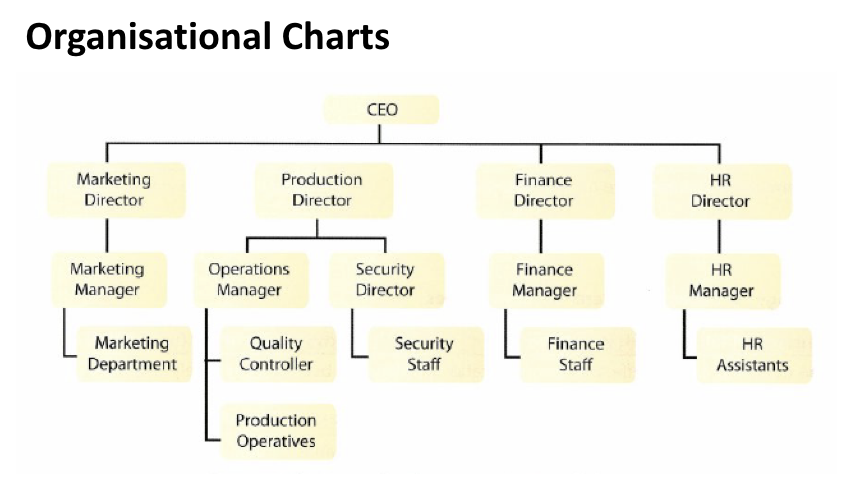
Tall/Vertical Organization Structure
Multiple hierarchy levels: Narrow span of control
Centralized decision-making: Directors and seniors makes decisions.
Top-down communication: Decision flow from the top levels.
Emphasis on Hierarchy: Seniority is respected
Clear career path: Promotion for senior roles.
Slow decision-making: Hinder response to external change.
High cost: Large management structure is expensive.
Flat/Horizontal Organizational Structure
Fewer hierarchical levels: Wider span of control
Decentralized Decision-Making: More autonomy at lower levels
Increased delegation: Managers handle more employees.
Efficiency and Flexibility: Fast decision-making and adaptability.
Limited supervision: Close oversight can be difficult with many direct reports.
Organizational Structure by Functions
Department-Based: Hierarchy revolves around functions like marketing, HR, and finance.
Specialization: Experts work in their specific areas.
Coordination challenges: Difficult for departments to align.
Growth issues: Departments can compete for resources, potentially prioritizing their needs over the company’s.
Organization Structure by Region
Geographical Focus: Structure based on regions (countries/continents)
Common in Global Businesses: Used by companies operating in many countries.
Regional Autonomy: Better adaptation to local markets and needs.
E.g. Multinational companies likes HSBC bank organize by geographical areas.
Organization Structure by Product
Product-focused: Employees concentrate on the specific needs of customers for a particular product/brands.
Motivation&Loyalty: High levels of commitment to specific products or divisions.
Autonomy: Divisions may have significant control over finance and decision making.
Isolation risk: Decisions made without considering overall business objectives.
E.g. BBC organizes divisions based on services like music, news, media.
Technology Impacts on Communication
More information for decision-making via data (e.g. loyalty cards)
Shift towards decentralization: Junior employees can make data-supported decisions
Rise in flatter structures: Faster response to customer feedback (social media)
Social media management: Teams responding quickly to customer issues.
Culture Impacts on Communication
Language proficiency is a highly valued communication skill. Knowing the native language are vital in many occupations in certain parts of the world.
Accents can hinder communication
Cultural ignorance can cause offense to others.
The main solution is to recruit bilingual or multilingual employees.
Henri Fayol Key Functions of Management
Planning - tactical and strategic
Commanding - giving instructions/orders
Controlling - performance, health, safety,
Coordinating - departments work together
Organizing - organizing resources to achieve objectives.
Charles Handy Key Functions of Management
General Practitioners
Confronters of dilemmas
Balancers of cultural mixes
Effective managers requires to see the bigger picture of different situations.
Peter Drucker Key Functions of Management
Setting organizational objectives
Organizing tasks and people
Communicating with and motivating people.
Measuring performance.
Developing people
He argues that managers don’t get too involved with employee’s daily activities (decentralized structure), and that people are essential to a company’s success.
Leader & Leadership
A leader is someone who influence and inspire people to get things done. They foster motivation, respect, trust and loyalty.
Leadership is a process of influencing and inspiring others to achieve organization goals.
Leaders focuses on achieving broad goals with no definite time frame.
Manager & Management.
Management is the ‘art of getting things done through people’
Managers focus on achieving specific goals with a time frame.
They do problem solving, planning, organizing human/capital resources to achieve organizational objectives.
Leadership vs. Management
Leaders spend more time and devotion and a direct influence on employees by inspiring them to work. Leaders take risks and act upon their vision of the company’s best interest.
Managers spend less time and instruct employees to do work. They follow rules and don’t take risk as often.
The skills require to be an effective manager and leader have a lot of overlap despite the distinction. Being a leader almost is a innate characteristic.
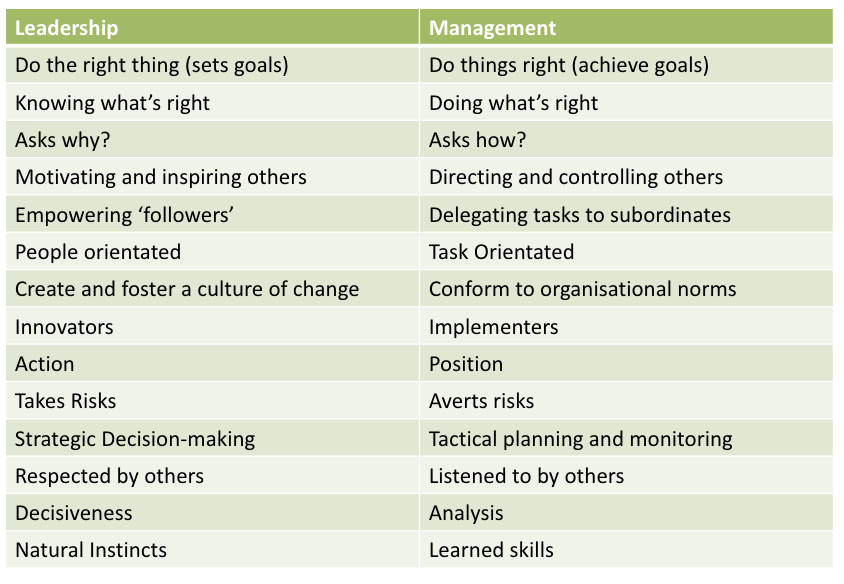
5 Common Leadership Styles
Autocratic
Paternalistic
Democratic
Laissez-Faire
Situational Leadership
Autocratic Leadership
Makes all the decisions
Prefers not to delegate any responsibility
Only tell subordinate what to do.
This style is suitable when quick or critical decision-making is needed. This style also applies when workers are unskilled and depend on directions of leaders.
Autocratic Leadership Limitation
Communication is top-down and opinions of employees are ignored, which can demotivate them and create resentment in the workplace.
Paternalistic Leadership
Treat their employees like a family member by guiding them and acting in their best interest.
Exceptional organizational skills and build trust with teams.
Workers are expected to be loyal and obedient. This style works well in countries with cultures that enables people to work hard out of gratitude for leaders. In other cultures this might not work well, people don’t want to be dictated by others.
Positive vs. Negative Paternalistic Style
A negative paternalistic style occurs when leaders perceives the workers as less capable and therefore guide them
A positive paternalistic style occurs when leaders perceives the workers as highly capable so they nurtures and develop them.
Democratic Leadership
Involving employees in the decision making process, bringing out more employee satisfaction as employee have input.
Idea sharing can improve decisions.
This can work when leaders are not present, and employees remain on tasks.
Democratic Leadership Limitations
It can delay decision making because it involves many people and is not suitable for a large workforce.
Laissez-Faire (don’t care)
Minimal direct input in employee’s work and instead allow employees to make their own decisions.
Leader sets the objective, and the employee decide the best approach. This can highly motivate workers as they feel trusted and valued.
This style is suitable when creativity is important, such as computer software or advertising agencies.
Laissez-Faire Limitations
Coordination and decision-making can be time-consuming with lack of direct supervision or support.
It relies heavily on teamwork and the goodwill of employees to achieve the organizations goals.
Laissez-faire leadership can encourage slack and laziness since employees are not closely monitored.
Situational Leadership
This is a leadership style is not based on a dominant approach. It’s about using the right leadership style for the right situation. This style suggests that managers and leaders change their style to accommodate different situations.
Factors that Influence Situation Leadership (CLOTS)
Culture - The type of culture that exists in the organization and group norms
Leader - The trust leaders have for employees, how skilled they are, their preferred leading style
Organizational structure - What is the structure? Tall/Flat? Span of control?
Task - Task difficulty, urgency, importance.
Subordinate - Skills and number of employees.
Motivation
Motivation is the desire and energy to achieve something. It’s the enthusiasm to complete the task. If employees are not motivated, then it can affect the company’s productivity.
Benefits of Highly Motivated Workers
Higher morale and job satisfaction
Better industrial relations
Lower absenteeism
Lower staff turnover
Improves corporate image
Higher profitability
Signs of Poorly Motivated Staff
High absenteeism rate
High labour turnover rate
High wastage level
Increasing number of customer complaints
Low quality output
Poor punctuality (on time)
More disciplinary problems
5 Main Motivational Theories
Taylor
Maslow
Herzberg
Adams
Pink
Taylor - Scientific Management
Piece-rate payment systems, suggesting that workmen want higher wages from employers above anything else. Taylor assert that productivity could be improved by setting goals that relate to pay (more work=more pay). He also promote division of labour (specialization) in the production process to improve efficiency.
Taylor’s Theories Limitation
Criticized for ignoring non-physical contributions of workers (doctors, teachers).
Ignore non-financial factors that motivate people.
Fail to acknowledge that workers can be innovative and independent.
Employees don’t feel that financial compensation is sufficient relate to drawbacks of the system.
Maslow’s Theory - Hierarchy of Needs.
He believes that people are motivated more than just money and argue that basic needs (e.g. hunger) must be met before focusing on higher needs (recognition or esteem.)
Hierarchy of Needs
Psychological (basic) needs - needs that are essential for survival (food, air)
Security (safety) needs - things necessary to make people feel safe and stable (daily structure/routine, protection from harm).
Social (love/belonging) needs - human desire to be included, loved, and accepted by others (communication, gatherings).
Esteem (ego) needs - desires for recognition and self-respect, people should feel good about themselves.
Self-actualization refers to the forces that drives people to be the best versions of themselves.
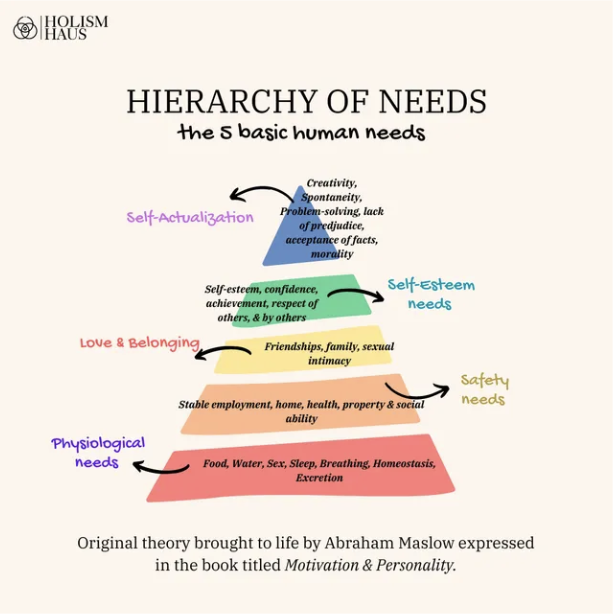
Maslow Theory Limitation
It might not be realistically feasible for a business to motivate all workers according to the hierarchy of needs.
Levels of needs are difficult to measure
Maslow assume people are motivated in the hierarchy’s chronological order.
No true explanation of what motivates people when they reach self actualization.
Herzberg - Two factor theory
Herzberg theory has two main categories of factors affecting workplace motivation.
Hygiene factors (mainly physical aspects)
Motivators (mainly psychological aspects)
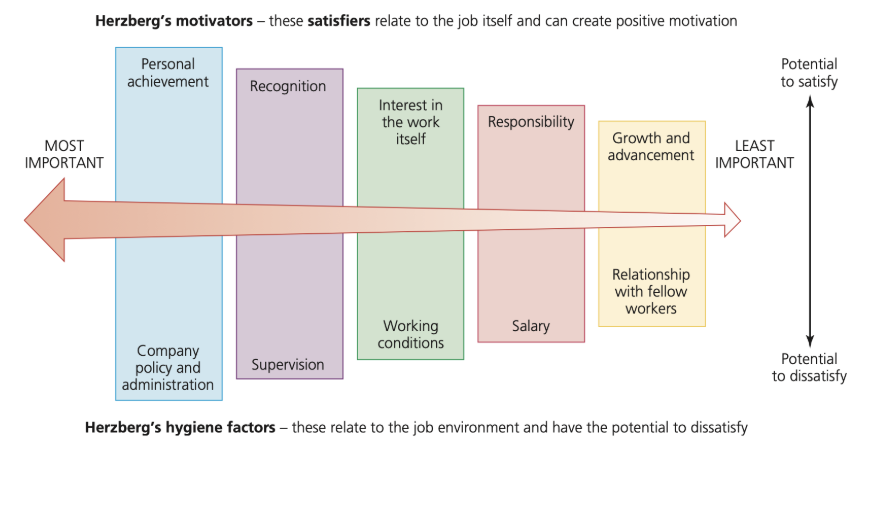
Herzberg Motivators
Achievement
Advancement
Interesting tasks
Promoting opportunities
Personal growth
Recognition
Responsibility
The work/job itself
Motivation Theories Main Findings
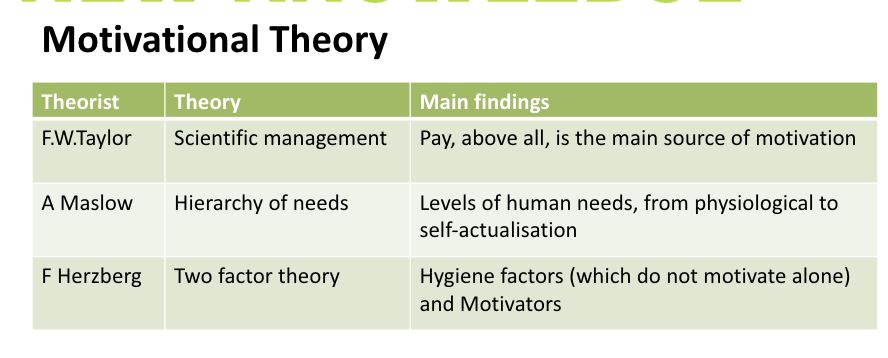
Financial Rewards (forms of monetary payment)
Salary
Wages (time/piece rate)
Commission
Profit-related pay
Performance-related pay
Employee share ownership schemes
Fringe payment (perks)
Salary
Set at a fixed annual rate but paid in a monthly basis (e.g. $36,000/year is paid $3000/month)
Salaries can improve firm’s cash flow as workers are paid a fixed amount once a month.
Salaried workers work more than their contracted hours but are unlikely to be paid for extra work or overtime.
Salaries are used where output/productivity cannot be measured to do piece-rate.
Salaries Limitations
Two key disadvantaged:
Since distinguishing the efforts or output of different is difficult, it is hard to reward those who are more productive.
There is little incentive to work harder since people are payed the same amount.
Wages (time and piece rates)
Wages are the reward for labour services, usually expressed as an hourly rate (time) or as a measure quantity output. Can be paid per hour, day, week. It is also dependent on the worker’s experience. They also get paid if worked overtime.
Pro/Con Wages (Time rate)
Advantages - easily understood by employees
Disadvantages - not rewarded for effort but time, can encourage poor productivity.
Piece rate
Payment system that can get the issue of wages by rewarding worker’s productivity. This ensures that workers are paid for the amount of work they actually do and have an incentive to work.
Piece-rate limitation
Quality of the output can be reduced therefore supervision and quality control is needed. It is also uncertain as well since income can be reduced based on factors like machine failure which is out of their control.
Salary Vs. Wages
Two terms should not be used interchangeably, salaries are fixed costs whereas wages are a variable cost. It is better to use terms like ‘remuneration’ or ‘earnings’.
Commission
Commission pays workers based on a percentage of the sales or output contributed by the worker. (e.g. real estate agents get 1% of the value of each property sold, selling a $500k property would earn them $5k.) They do have a base salary, commissions are only there to boost earnings.
Commissions limitations
Added pressure on workers to sell faster
Task can be repetitive causing boredom
It might result in not great customer care
Workers aren’t sure of their pay amount due to the commissions
Profit-related pay
Pay to the levels of profits in the firm (greater the profit, greater the pay). It is usually paid as an annual bonus. It can be used to strengthen employee loyalty and foster team spirit, boosting labour efficiency.
Profit-related pay limitations
Proportion of profits is often seen as too small to provide incentive.
Individual efforts is not recognized by this system, no reason to improve performance.
In reality, this system is used to reward senior managers than the whole workforce.
Performance Related Pay
It is a more flexible reward system, where it rewards employees (as individuals, teams, or whole workforce) who meets certain goals.
Ways Performance Related Pay is Administered
Pay rise - increase in pay
Performance bonus - paid to workers who have reached targets
Gratuity - paid to staff who complete employment contracts (end of contract bonus)
Performance Related Pay limitations
Targets might be unrealistic or unachievable which can hinder job performance
Pressure to achieve targets can create stress
It might not encourage teamwork, especially when workers feeling alienated when their coworkers are better rewarded.
Ignoring non-financial motivators
Employee share ownership schemes
This system rewards workers, managers and directors by giving them shares in the company or selling the shares at discounted price. It is often used as alternative to cash bonus or profit sharing. This can make employees have a more direct interest in the wellbeing of an organization.
Employee share ownership schemes limitations
In reality, share ownership schemes tend to be used for rewarding senior leadership. Majority of employees do not qualify for share ownership
Even if employees do quality, the amount given is small and doesn’t sustain their motivation.
Fringe Payments (perks)
The financial benefits to employees in addition to their wage or salary (e.g health insurance, housing allowance, staff discounts, gym membership, paid holidays)
Perks can vary from one firm to another and might depend on employee’s rank.
Pro/Con Fringe Payments
+ They encourage employee loyalty. Perks can help meet employee’s safety needs and make workers feel valued.
- It can be high cost to implement.
- Senior managers might qualify for more benefits.
Non-financial rewards
Non-monetary factors that motivate people by offering psychological and intangible benefits. E.g:
Job enrichment
Job rotation
Job enlargement
Job enrichment
Giving more challenging jobs with more responsibilities. People have greater authority and autonomy in their work with better opportunities to accomplish. Workers can have a better sense of achievement and become more committed.
Job rotation
A type of job enlargement that involves workers performing different tasks at the same level of complexity in a systematic way. This provides more variety to avoid problems of over specialization and can make it easier to cover for absent colleagues. It can require greater training cost and regarded to other employees as increasing their workload.